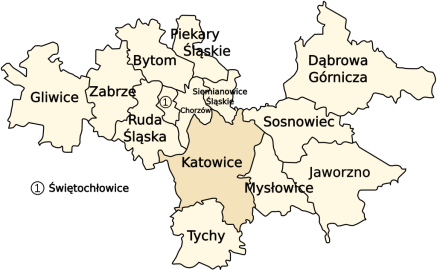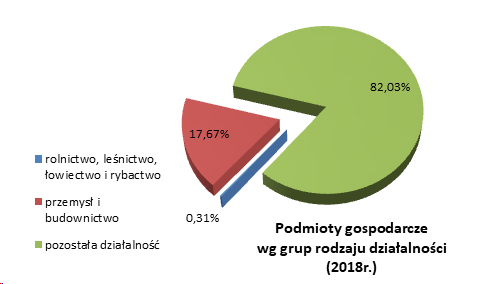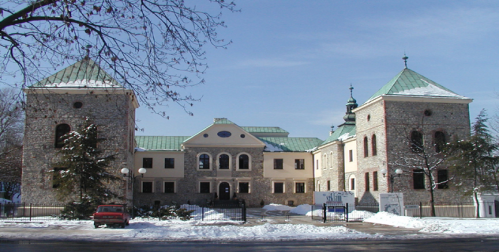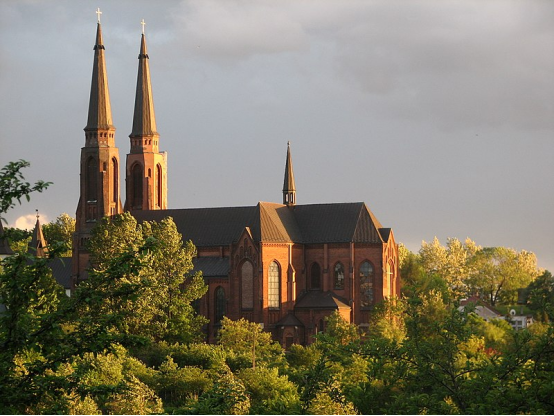Sosnowiec- Silesian 作者: 来源: 发布时间:2021-05-20
Ⅰ. Population and Area
Population (31 December 2019)
• City 199,974 Decrease (16th)
Area
• City 91.06 km2 (35.16 sq mi)
Website
http://www.sosnowiec.pl
Ⅱ.Natural Geography
It is believed that the name Sosnowiec originates from the Polish word sosna, referring to the pine forests growing in the area prior to 1830. The village was originally known as Sosnowice. Other variations of the name include Sosnowietz, Sosnowitz, Sosnovitz (Yiddish), Sosnovyts, Sosnowyts, Sosnovytz, Sosnowytz, and Sosnovetz. There are five other smaller settlements in Poland also called Sosnowiec, located in the Kielce Voivodship, Łódź Voivodship, and Opole Voivodship.
Sosnowiec within the Silesian Metropolis, 2012
Sosnowiec serves as one of the administrative centres of the geographical and historical area of southern Poland known as the Zagłębie Dąbrowskie (the Dąbrowa Basin). It lies within the historic Lesser Poland region near the border with Silesia. It is located about 10 km (6.2 mi) north-east to the centre of Katowice and 65 km (40 mi) north-west of Kraków, situated in the Silesian Upland on the rivers Brynica and Przemsza, a tributary of the Vistula. The full list of rivers includes Biała Przemsza as well as Czarna Przemsza, Brynica, Bobrek, and Potok Zagórski creek. The city is part of the Silesian Voivodeship since its formation in 1999. Previously (since 1945), it was part of Katowice Voivodeship, and before World War II, Sosnowiec belonged to Kielce Voivodeship.

Transport
Sosnowiec is one of the largest cities in the Silesian Province, located in the southern part of Poland. It covers an area of 91.06 km 2 and has 198,432 thousand square meters. inhabitants (as of December 31, 2017)
It has very good communication conditions with the neighboring cities: Katowice, Dąbrowa Górnicza, Będzin, Czeladź and Mysłowice. It is a well-connected city - there is a national road connecting Silesia with Warsaw, as well as Łódź and Gdańsk. The A4 motorway from Wrocław to Kraków runs 12 km from the city center. Another advantage of the city is the direct railway connection with major cities in Poland and several European capitals. The Katowice - Pyrzowice Airport is located not far from Sosnowiec, and the Balice Airport near Krakow is 70 km away. The airport in Pyrzowice serves planes of all basic categories and has a permanent connection to national airports and the most important airports in Europe.
A very important communication advantage of Sosnowiec is its direct vicinity to the town of Sławków, where the Broad-Gauge Metallurgical Line (1520 mm track gauge) ends, running from the border with Ukraine. The possibility of transporting goods and trucks on wagons now allows the line to be used to handle goods exchange with Ukraine and Russia.
Ⅲ.Economy
Employed persons by economic sectors in Sosnowiec

Economic entities by type of activity groups (2018)

-WhySosnowiec? http://www.sosnowiec.pl/biznes/artykuly/k1,59,inwestuj_w_sosnowcu/k2,1177,inwestorzy/k3,1178,dlaczego_sosnowiec/
Sosnowiec is characterised by its urban dynamics, economic activity, cultural heritage, and natural environment. In recent years, Sosnowiec was further developed from an industrial centre (with mainly mining and heavy industries) into a hub of trade and services. Nevertheless, it still operates several important coal mines, steel factories and other industrial plants. Its Special Economic Zone, established in Sosnowiec thanks to the efforts of local authorities, plays a major role in attracting new businesses into the area. As a result, several companies with Polish and foreign capital opened their businesses in the city. Sosnowiec City Office was awarded the ISO 9001 2001 quality certificate for its management system for providing services for the local community.
From 2006, a new trade centre Expo Silesia began hosting numerous trade shows. Activities of Artistic and Literary Society of Zagłębie Dąbrowskie prove also that Sosnowiec as an industrial centre is not only a working-class environment.
Ⅳ.Industrial Characteristics
Until the beginning of the 1990s, the basis of Sosnowiec's economy was heavy industry: mining and metallurgy. The restructuring of these industries brought about a change in the economic structure of the city, which took on a commercial, service and processing character. The current economy is multi-branch and its structure is dominated by small and medium-sized private companies. Local enterprises constantly adapt their technologies to the needs of the market and world standards.
A number of institutions supporting the economy operate in Sosnowiec: the Local Development Agency, the Regional Chamber of Industry and Commerce, and the Regional Chamber of Commerce. Their tasks include conducting trainings, implementing new technologies and forms of management, economic and legal consulting. The Local Development Agency also runs a Credit Guarantee Fund and a Loan Fund for enterprises starting or already running a business. An employment agency is also run by ARL.
The development is noted by logistics centers, companies in the following industries: electronics, machinery, food, car accessories, both domestic and foreign. Due to the attractive location, as well as the existence of the Katowice Special Economic Zone and the Sosnowiec Science and Technology Park, domestic production plants and branches of global concerns have been established in Sosnowiec since 2000.
Key project program
1. Lokal na Biznes
The "Lokal na biznes" program is aimed at people who, after completing their education, want to run a business in the capital of Zagłębie or have already established one, but not earlier than six months ago.
Lokal na Biznes - Application deadline extended until April 30, 2018 http://www.sosnowiec.pl/biznes/aktualnosci/k1,6,gospodarka/id,13882,lokal_na_biznes_-_znamych_pierwszych_najemcow.html
2. Sosnowiec will have its gem - the construction of the new Egzotarium is starting!
This is for sure! Sosnowiec Exotarium will change beyond recognition. An agreement has just been signed under which the Ecological Education Center will be built in the place of the current Exotarium. It will be a unique facility in southern Poland, complemented by the nearby Biodiversity Park.
Sosnowiec will have its gem - the construction of the new Egzotarium is starting! http://www.sosnowiec.pl/biznes/aktualnosci/k1,9,inwestycje/id,17207,sosnowiec_bedzie_mial_swoja_perelke__rusza_budowa_nowego_egzotarium.html
Attractions
Ⅴ.Attrations and Cityscape

Sielecki Castle

St. Joachim's Church
It is difficult for our city to compete with the history and monuments of Wrocław or Kraków, but there are undoubtedly special places in Sosnowiec that are worth seeing. They mean a lot to us, because it is our past and history, the history of our grandfathers and great-grandfathers.
Historic architectural gems attract the attention of not only tourists but also art experts. The Silesian Center of Cultural Heritage recognized the palaces of Sosnowiec as the most beautiful residences in the region from the turn of the 19th and 20th centuries. Therefore, we encourage you to get to know our city better.
Undoubtedly, one of the most interesting and beautiful places worth seeing in Sosnowiec is the 19th-century palace of Henryk Dietl. The present palace has a neo-baroque character. The current owners are carrying out major renovation works, thanks to which the property returns to its splendor.
Another place on the route of our trip around Sosnowiec is the baroque residence of the Schoen family, which today houses the Museum. The main hall and the staircase leading to the first floor of the Palace, with its wonderful stained glass windows, delights with its originality. It is also worth taking a look at the trees growing in the local Park. Experts will find here really interesting specimens, imported by owners from all over the world. The park is also a favorite place for walks of Sosnowicz inhabitants.
The city's showcase is the restored Main Railway Station, which was created as a result of the plan of delineating the route of the Warsaw-Vienna railway. Erected in 1859 in the neoclassical style with minor modifications, it was modeled on the previously realized project of the building of the Vienna Railway Station in Warsaw.
The fate of the oldest monument in the city - the Sielecki Castle is also interesting. The first mentions of this building date back to 1403. Even then, there was a medieval fortress in the place of the present castle. Unfortunately, virtually no remains have survived to the present day.
In addition to the historic secular buildings, there are interesting religious monuments in the city. Among them, the Cathedral Church of the Assumption of the Blessed Virgin Mary and the Orthodox Church deserve special attention. The church was built in the years 1893-1906 in the neo-Romanesque style. Inside the church there are frescoes, scenes from Polish history, made by outstanding artists Włodzimierz Tetmajer and Henryk Uziembło. Włodzimierz Tetmajer is the author of many polychromes decorating Polish monuments, incl. the cathedral on Wawel, the church in Wieliczka, Kalisz or Kalwaria Zebrzydowska. The city of Sosnowiec has for many years financially supported the renovation of the paintings, which slowly regain their former glory.
The Orthodox Church of St. Vera, Nadezhda and Lubowi situated near the railway station. It was built in the years 1888-1889 for local Russians, railroad workers and administration officials. Funds for its construction were obtained from public collections. The building, built of brick and stone, was erected on the plan of an isosceles cross. The central, octagonal part is topped with an onion-shaped cupola. The element that distinguishes the Sosnowiec church from other churches of this type, built at the end of the 19th century, is the four-story belfry.
It is worth getting to know Sosnowiec and the places that the guides write about. This is a true story, the story of the people who built this city and were an important part of it. It is therefore worth seeing up close and feeling the atmosphere of this unique place.
Points of interest
There are many relics of the industrial era, especially residences of industrialists. Most of them are located outside the strict city center, on the Czarna Przemsza river bank. One of the oldest is a 17th-century castle known as the Sielecki Castle.
Ⅵ.History and Culture
Sosnowiec is a city with a rich cultural base. The cultural institutions in Sosnowiec include: Sala Koncertowa im. J. Kiepura at the Music School Complex, Miejski Klub im. Jana Kiepura, the Muza Show and Concert Hall, the Energy Cultural Center, the Zagłębie Theater - one of the oldest institutions in the city (older than the city itself), the Sosnowiec Art Center - Sielecki Castle, the Museum in Sosnowiec, the Gustaw Daniłowski Municipal Library and the modern Municipal Media Center "Kazimierz" Community Center, the "Maczki" City Club, Cinema City Cinema, Helios Cinema. The most valuable monuments include the Sielecki Castle, railway stations - Sosnowiec Główny and Sosnowiec Maczki, factory palaces of Dietl and Schoens, an Orthodox church and numerous churches
The history of the city in its proper sense begins in 1902 when it was granted city rights by merging a number of settlements often several centuries old. However, the history of the village of Sosnowiec dates back to the year 1227, when it was mentioned for the first time. It then was a small settlement in the Polish Duchy of Kraków, located in close vicinity of much larger and better-developed villages of Sielce and Zagórze (both are now districts of the city). Other districts are even older. Milowice was first mentioned in 1123 as Miley. Documents from 1228 already mention Milowice, Klimontów, and Zagórze. Furthermore, Milowice was placed on a 1561 map.
As part of the Polish–Lithuanian Commonwealth, Sosnowiec belonged to Kraków Voivodeship, one of three voivodeships of Lesser Poland. It became a border town after the neighbouring Duchies of Silesia passed to the Bohemian Crown in 1335. In the result of the Third partition of Poland in 1795, however, it was seized by the Kingdom of Prussia and was included into the newly established province of New Silesia. During the Napoleonic Wars, it became part of the Duchy of Warsaw in 1807 and later, of Congress Poland ruled by the namiestniks of the Russian Empire. Located at the borders with the German Empire and Austria-Hungary, Sosnowiec became famous for the Three Emperors' Corner tripoint, which was located within current limits of the city.
Ⅶ.Other Information
Sosnowiec is an industrial city county in the Dąbrowa Basin (Zagłębie Dąbrowskie) of southern Poland, in the Silesian Voivodeship, which is also part of the Silesian Metropolis municipal association. Located in the eastern part of the Upper Silesian Industrial Region, Sosnowiec is one of the cities of the Katowice urban area, which is a conurbation with the overall population of 2.7 million people; as well as the greater Upper Silesian metropolitan area populated by about 5.3 million people. The population of the city is 199,974 as of December 2019
Ⅷ.Contact Information
-Mayor Arkadiusz Chęciński
-Municipal Office in Sosnowiec , aleja Zwycięstwa 20, 41-200 Sosnowiec
-phone: (32) 296-0-600, fax: (32) 296-0-605
-e-mail: um@um.sosnowiec.pl
